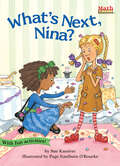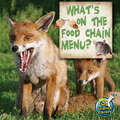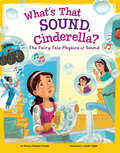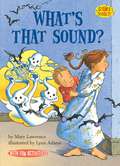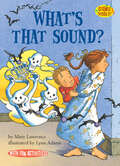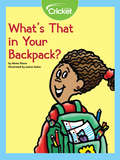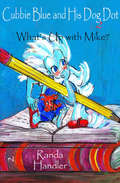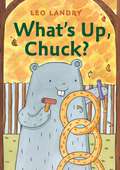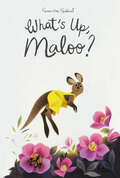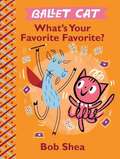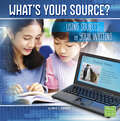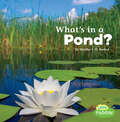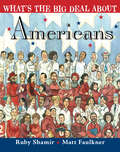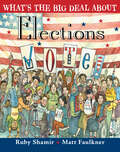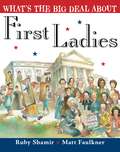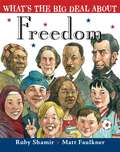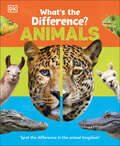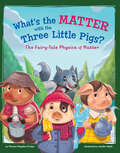- Table View
- List View
What's Next, Nina?: Patterns (Math Matters)
by Sue KassirerDiscover Math Matters! With over 15 million books sold worldwide, this award-winning series of easy-to-read books will help young readers ages 5–8 approach math with enthusiasm. Great for fans of MathStart or Step into Reading Math. Nina borrows her sister's necklace to wear to a big fancy party. When the unthinkable happens, what will she do?With engaging stories that connect math to kids&’ everyday lives, each book in the Teachers&’ Choice Award–winning Math Matters series focuses on a single concept and reinforces math vocabulary and skills. Bonus activities in the back of each book feature math and reading comprehension questions, and even more free activities online add to the fun! (Math topic: Patterns)
What's Older Than a Giant Tortoise?
by Robert E WellsIf medals were awarded to animals for living a long time, then a giant tortoise would certainly win one. Some giant tortoises have lived for more than 150 years! Still, there are things on this planet much older than giant tortoises. Some of the giant sequoia trees that grow in California would be more than 3,000 years old. But the trees aren't that old compared to the Barringer Crater in Arizona--that was made about 49,000 years ago. And it's almost impossible to imagine that 65 million years ago, the T. rex dinosaur roamed this planet--but we have the skeletons to prove it!
What's On The Food Chain Menu? (My Science Library)
by Julie LundgrenIntermediate Readers Explore Who's Eating Who And Where.
What's Opposite?
by Stephen R. SwinburneUp and down, big and small, hot and cold--opposites are all around us. Learning to identify opposites is one way children expand their view of the world. Soon they see that some things are completely different from one another and why. Steve Swinburne explores opposites through a simple, lively text and bright, colorful photographs that clearly illustrate this important concept. By the end of this engaging book, children will discover how opposites make the world a rich and wonderfully varied place. As in What's a Pair? What's a Dozen?; Lots and Lots of Zebra Stripes; and Guess Whose Shadow?, Stephen Swinburne offers another lively and entertaining look at an all-important concept.
What's Smaller Than a Pygmy Shrew?
by Robert E WellsA pygmy shrew is among the tiniest of mammals. A ladybug is even smaller. But in this book you will find small things you could not ordinarily see.
What's That Sound, Cinderella?: The Fairy-tale Physics Of Sound (Stem-twisted Fairy Tales Ser.)
by Thomas Kingsley TroupeThe stepsisters yell. The fairy godmother sings. The pineapple-turned-monster-truck burns rubber on its way to the ball. For Cinderella, this evening is an enchanted STEM adventure through the science of sound. For readers, it's a treat of a fractured fairy tale, complete with an ear diagram, a key-term glossary, critical thinking questions, and a sweet pair of glass high-top sneakers.
What's That Sound? (Science Solves It! ®)
by Mary Lawrence Lynn AdamsAmy and Tim go to the country for a few weeks. Dad loves the peace and quiet. But Tim is spooked because he thinks the house is full of scary noises.
What's That Sound? (Science Solves It!)
by Mary LawrenceSolve kid-sized dilemmas and mysteries with the Science Solves It! series. These fun books for kids ages 5–8 blend clever stories with real-life science. Why did the dog turn green? Can you control a hiccup? Is that a UFO? Find the answers to these questions and more as kid characters dive into physical, life, and earth sciences. Two weeks in the country—it&’s the perfect summer getaway for Amy and Tim&’s family. But the house looks haunted, and they hear spooky sounds everywhere. Creaks and squeaks, rattles and rumbles. Could Amy and Tim be sharing their summer spot with a ghost? Books in this perfect STEM series will help kids think like scientists and get ahead in the classroom. Activities and experiments are included in every book! (Level One; Science topic: Sound)
What's That in Your Backpack?
by Mona PeaseAre you carrying a forest on your back? Of course not! But if you dig through your backpack, you will probably find many things that come from the forest.
What's Up with Mike?: Cubbie Blue And His Dog Dot Book 2 (Cubbie Blue and His Dog Dot #2)
by Randa HandlerDerek, Chris, and Brian, three seven-year-old boys, befriend Derek's new neighbor, Mike, who is blind. Their special friend, Cubbie Blue, a three-inch-tall being with supernatural powers, and his minuscule dog, Dot, help the boys learn about Mike's limitations and needs. This important knowledge allows them to properly welcome Mike to the neighborhood. In turn, the boys help Cubbie escape from the evil soldiers trying to capture him, and he is saved by their bravery.
What's Up, Chuck?
by Leo LandryA hilarious follow-up to Grin and Bear It, this early reader offers lessons on jealousy, self-confidence and the art of making new friends.Chuck Wood is upset. Jealous, too. Also insecure. As the winner of the Best of the Forest art contest three years in a row, he finds it very difficult to deal with the prospect that newcomer Scooter Possum&’s abstract paintings might beat his wood sculptures. But with the help of his forest friends, Chuck deals with his hurt feelings and realizes that his love for creating art is greater than his need to win. When you follow your heart, everyone&’s a winner.
What's Up, Maloo? (Maloo and Friends)
by Geneviève GodboutMaloo the kangaroo has lost his hop. Can his friends help him find it again? This sweet picture book explores the idea of sadness and the importance of friendship through ups and downs.No other kangeroo can hop like Maloo! But one day Maloo's friends find him stepping instead of hopping. What's wrong, Maloo? His pals look for ways to help Maloo regain the spring in his step. With patience, support and a little "hop" from his friends, Maloo gets his bounce back.Simple text and adorable art convey the power of friendship over a gloomy mood in Geneviève Godbout's charming debut as both author and illustrator.
What's Up?: Watching the Night Sky (Into Reading, Level N #56)
by Olivia SnowNIMAC-sourced textbook <p><p> Have you ever gone outside to look at the night sky? This book can help you learn what to look for.
What's Your Favorite Favorite (Ballet Cat)
by Bob SheaBallet Cat and her cousin, Goat, try to outdo one another while putting on a show for their grandmother.
What's Your Source?: Using Sources In Your Writing (All About Media Ser.)
by Brien J. Jenningsmedia studies; media literacy; types of media; internet safety; using sources; sources; analyze media; what's your source
What's a Pair? What's a Dozen?
by Stephen R. SwinburneThe world is filled with numbers. From learning to count their fingers to learning to put on their shoes, children encounter mathematical concepts early in life. Steve Swinburne introduces children to number-related words in this bouncy, colorful photo-essay. From one to a dozen, lively photographs illustrated math words such as single, double, couple, and prefixes such as uni-, bi-, and tri-. The second half of the book is presented as a guessing game. Following Lots and Lots of Zebra Stripes and Guess Whose Shadow?, Steve Swinburne offers children another entertaining look at an all-important concept.
What's for Lunch? (Let's-Read-and-Find-Out Science 1)
by Sarah L. ThomsonRead and find out about the different kinds of food we eat and how to fill up your plate to keep your body healthy in this colorfully illustrated nonfiction picture book.What's for lunch? Your body needs lots of different things to eat, and every kind of food has a different job to do. Did you know drinking milk makes your bones strong? Or that eating carrots helps you see better?This is a clear and appealing science book for early elementary age kids, both at home and in the classroom. It includes a find-out-more section with simple guides to learn about everyday healthy eating. Both text and artwork were vetted for accuracy by Dr. Carolyn Johnson, PhD, FAAHB, NCC, LPA, and Keelia O'Malley, MPH.This is a Level 1 Let's-Read-and-Find-Out, which means the book explores introductory concepts perfect for children in the primary grades. The 100+ titles in this leading nonfiction series are:hands-on and visualacclaimed and trustedgreat for classroomsTop 10 reasons to love LRFOs:Entertain and educate at the same timeHave appealing, child-centered topicsDevelopmentally appropriate for emerging readersFocused; answering questions instead of using survey approachEmploy engaging picture book quality illustrationsUse simple charts and graphics to improve visual literacy skillsFeature hands-on activities to engage young scientistsMeet national science education standardsWritten/illustrated by award-winning authors/illustrators & vetted by an expert in the fieldOver 130 titles in print, meeting a wide range of kids' scientific interestsBooks in this series support the Common Core Learning Standards, Next Generation Science Standards, and the Science, Technology, Engineering, and Math (STEM) standards. Let's-Read-and-Find-Out is the winner of the American Association for the Advancement of Science/Subaru Science Books & Films Prize for Outstanding Science Series.
What's in Your Pocket?: Collecting Nature's Treasures
by Heather L. MontgomeryCharles Darwin, George Washington Carver, and Jane Goodall were once curious kids with pockets full of treasures!When you find something strange and wonderful, do you put it in your pocket? Meet nine scientists who, as kids, explored the great outdoors and collected "treasures": seedpods, fossils, worms, and more. Observing, sorting, and classifying their finds taught these kids scientific skills--and sometimes led to groundbreaking discoveries. Author Heather Montgomery has all the science flair of a new Bill Nye. Book includes the Heather's tips for responsible collecting.
What's in a Pond? (What's In There? Ser.)
by Martha E. H. RustadTake a peek inside this easy-to-read book to discover the plants and animals living in a pond. Excellent photos and a simple design beautifully support early readers.
What's the Big Deal About Americans (What's The Big Deal About #4)
by Ruby ShamirFrom Native American traditions to immigrant inventions, from diversity to democracy, from ice cream cones to apple pie, this fun and fact-filled book--now in chapter book format!--celebrates the melting pot and mosaic that is America. A perfect way to start a conversation about America with young readers.Did you know that the inventor of American cheese actually came from Canada? Or that founding father Benjamin Franklin was inspired to create a democratic society by a confederacy of Native American tribes who came together to stop their constant warring? How about that both "God Bless America" and "White Christmas" were written by Irving Berlin, a Russian Jew who fled to the U.S. because of persecution back home?This entertaining, fact-filled book, perfect for fans of the Who Was series, is a great way to talk about the idea that people have come to America from many countries, in many ways, for many reasons. Americans have many different beliefs, different languages, and different traditions. But even with all of these differences, America comes together with the understanding that our country and government is "of the people, by the people, and for the people." And there's nothing more American than that.With full-color illustrations throughout and a timeline of American history and additional reading resources at the end, this book is a perfect introduction to the story of America.
What's the Big Deal About Elections (What's The Big Deal About)
by Ruby ShamirFrom campaigns to voting booths, from local elections to national races, this fun and fact-filled book--now in chapter book format!--celebrates the fundamental American idea that "we the people" get to decide who runs the show. A perfect way to start a conversation about American elections with young readers.Did you know that we have more than ninety thousand state and local governments in the US? Or that Election Day celebrations two hundred years ago featured marching bands and bonfires? How about that George Washington was our only president who ran unopposed?Elections allow adult citizens the chance to choose how our cities, states, and country are run. Even kids who can't vote yet can make their voices heard by helping the candidates they like get votes! Our elections can seem complicated, but at their core they're all about having a say in our own lives and future. In this fun and fact-filled chapter book, readers learn just how important being an active participant in our democracy can be through one simple message: Elections matter, and we can all play our part.This entertaining, fact-filled book, perfect for fans of the Who Was series, is a great way to talk about American elections and the fact that we all have a voice and a role to play.With full-color illustrations throughout and a timeline of American voting rights expansions and additional reading resources at the end, this book is a perfect introduction to the story of elections in America.
What's the Big Deal About First Ladies (What's The Big Deal About #1)
by Ruby ShamirFirst Ladies are more than just wives of U.S. presidents! This fun, kid-friendly book of trivia and history shows that First Ladies help influence America in ways both large and small.Did you know that Mary Todd Lincoln hated slavery and helped to end it in America? Or that Edith Wilson helped decode secret messages during World War I? How about that Sarah Polk didn&’t let anyone dance in the White House while she was first lady? It&’s true! In addition to being hostesses, advocates, ambassadors, activists, patriots, and role-models, each first lady put her own stamp on the White House—and on our country. In this fun-filled, fact-filled book, you can find out just what made each first lady unique and why they were so important. As it turns out, first ladies are a pretty big deal after all! This book is perfect for fans of So You Want to be President? and Rad American Women from A-Z:Rebels, Trailbalzers, and Visionaries who Shaped Our History...And Our Future, and is a great entry point to discussing elections, inaugurations, and all aspects of the White House with children.Praise for What's the Big Deal About First Ladies:★ "A breezy way to, as Abigail Adams urged, 'remember the ladies.'" --Kirkus Reviews, starred review"This title does an excellent job of highlighting the important roles that these women played throughout history....A delightful introduction to America&’s first ladies for elementary U.S. history collections." --School Library Journal "Packed with interesting facts and illustrated with style, this upbeat overview of America&’s First Ladies will entertain kids intrigued by history." --Booklist
What's the Big Deal About Freedom (What's The Big Deal About #2)
by Ruby ShamirFrom the Constitution to civil rights, from women's rights to the four freedoms, this kid-friendly picture book filled with fun facts and historical trivia shows how America got the nickname "land of the free."It&’s a &“free country&”! Why? Because in America we're free speak our minds, choose our leaders and set the rules. Since way back when Thomas Jefferson wrote the Declaration of Independence, Americans have stood up for freedom again and again – but it wasn&’t always easy! Did you know that Henry &“Box&” Brown escaped slavery by shipping himself north in a box? Or that Susan B. Anthony was arrested when she tried to vote? Did you know that even young kids protested for the right to go to school? This entertaining, fact-filled book celebrates how, with every generation, more and more Americans won the right to be free. Find out how they did it and why standing up for the &“land of the free&” is such a big deal!Perfect for fans of The One and Only Declaration of Independence, John, Paul, George & Ben, and Shh! We're Writing the Constitution – and a great way to talk about America, its values, and the rights we all enjoy.Praise for What's the Big Deal About Freedom:"Bolstering the upbeat tone of the writing while emphasizing the racial and religious diversity of Americans, the lively watercolor-and-pencil illustrations are consistently engaging and occasionally endearing. A hopeful, idealistic portrayal of freedom in America." --Booklist"An effective place for children to begin learning about the concept of freedom." --School Library Journal
What's the Difference? Animals: Spot the difference in the animal kingdom! (Spot the Difference)
by DKBe prepared with all the facts you need to identify these commonly confused animals! How do you tell the difference between a llama and an alpaca? What really makes a crocodile different from an alligator? Is that a leopard, a cheetah or a jaguar? What&’s the Difference? Animals covers over sixty different regularly confused animals and discusses the similarities and differences between each of them. Fact files, vibrant photographs, and an answer to the question &‘What&’s the difference?&’ on every spread make this a wonderfully informative and fun book that will always tell you everything you need to know to spot the difference.
What's the Matter with the Three Little Pigs?: The Fairy-tale Physics Of Matter (Stem-twisted Fairy Tales Ser.)
by Thomas Kingsley TroupeWhat's the matter with the three little pigs? They're being tormented by a hungry wolf! And no matter what kind of matter they use to build their homes, it doesn't matter. The STEM-savvy, rhyme-loving wolf in this fractured fairy tale always seems to spoil the day. A glossary and critical thinking questions support the story's physics content.
